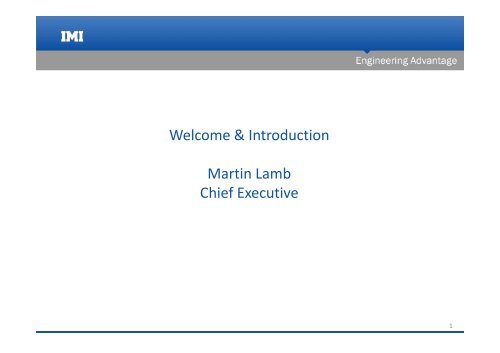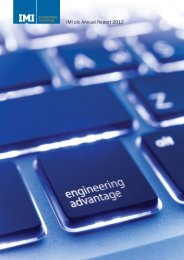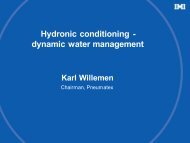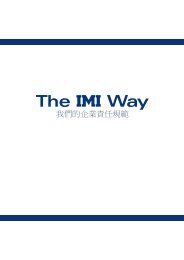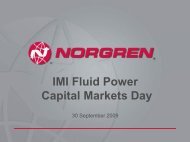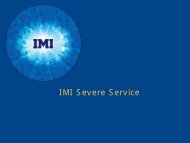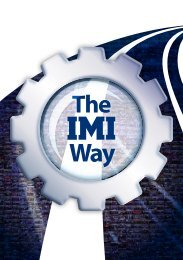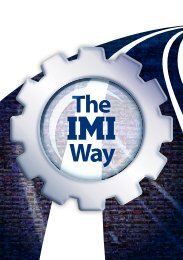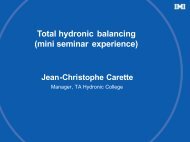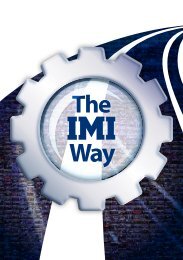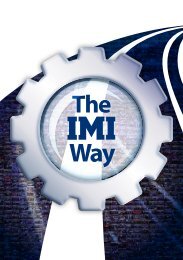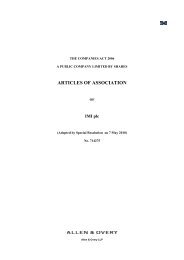Welcome & Introduction Martin Lamb Chief Executive - IMI plc
Welcome & Introduction Martin Lamb Chief Executive - IMI plc
Welcome & Introduction Martin Lamb Chief Executive - IMI plc
You also want an ePaper? Increase the reach of your titles
YUMPU automatically turns print PDFs into web optimized ePapers that Google loves.
<strong>Welcome</strong> & <strong>Introduction</strong><strong>Martin</strong> <strong>Lamb</strong><strong>Chief</strong> <strong>Executive</strong>1
Margin improvement 2001 – 2011Need to get DP to do circles in blue green and yellow as per last year – but able to edit text20.0%15.7%16.7%17.0%15.0%12.2%12.7%13.0%14.0%13.1%10.0%9.2%9.8%10.5%7.7%5.0%2001 2002 2003 2004 2005 2006 2007 2008 2009 2010 H1 2010 2011 H1Long term objective for each of the three Fluid Controls businesses is 20% and foreach of the Retail Dispense businesses is 15%4
<strong>IMI</strong> TomorrowNeed to get DP to do circles in blue green and yellow as per last year – but able to edit textStrategic ConvergenceFocusing on the “sweetspot”Fluid TechnologiesPrecision flow control in criticalapplications:• Valves• Actuators• Controllers & PositionersMarket Characteristics& core competencies• Market leadership in Global niches• Blue chip clients supported byworld class Key Account Management• Customised solutions deliveredthrough Engineering Advantage• Extensive aftermarketGrowth DriversClimate Changeclean energy/energy efficiency/environmental controlResource Scarcityprocess efficiency/labour automationUrbanisationbuildings efficiency/mass transit infrastructureAging Populationquality & longevity of life/lifestyle & diet5
Flow control fundamentalsControl LoopActuatorFeedback LoopController /PositionerValveProcess Loop6
Applications spectrumWaterSyrup, Water,CO 2Air, Oxygen,Exhaust gas,Reagent3mSteam,Gas, WaterOrifice size0.2mm600 barPressure1 bar 7
Applications focus• Challenging process environment– pressure / temperature / harsh environments• Critical outcome– high consequences of failure– high commercial returns for optimised performance– regulatory requirements– unique competitive advantage8
Agenda• <strong>Welcome</strong> & <strong>Introduction</strong> <strong>Martin</strong> <strong>Lamb</strong>• <strong>IMI</strong>’s core Fluid Technologies Santhosh Kumar (Beverage Dispense)Richard Edwards (Fluid Power)Jean Christophe Carette (Indoor Climate)Jon Landes (Severe Service)• Applications Showcase 4 Groups(i) What is critical aspect of design?(ii) Why is it important to the customer?(iii) What are the key physical principles involved?(iv) What are the implications of getting it wrong or sub optimisation?(v) How have we solved the problem?(vi) Why does the solution give us a competitive advantage?• Questions and Answers• Closing comments <strong>Martin</strong> <strong>Lamb</strong>• Refreshments9
Common Fluid TechnologyAn introduction to the underlying design principles andtechniques behind <strong>IMI</strong>’s engineering advantage approach10
Presentation OverviewPresentation Overview1. Design principles:Santhosh Kumar – VP Engineering (Cornelius)• The main system and performance parameters that must be considered andcontrolled during the design of a new product or technology2. Design optimisation tools:Richard Edwards – Technical Director (Norgren Life Sciences)• The key tools and techniques used to achieve the optimum system solution3. Benefits of optimised design (Engineering Advantage):Jean-Christophe Carette – Hydronic College Manager (TA Hydronics)• The benefits of delivering world class engineering advantage4. Consequences of sub-optimal design:Jon Landes – VP (<strong>IMI</strong> Severe Service)• The consequences of relatively small deviations in performance11
Design Principles13
Designing a flow control systemFundamental steps in designing a valve:1. Establish the required flow performance• Single phase (liquid or gas) or 2-phase• Fluid Properties• Capacity & flow rate• Accuracy & repeatability2. Identify the required pressure conditions• Pressure Drop & inlet pressure3. Decide the method of control & actuation• On-off or regulating/modulating• Response time• Mechanical or electrical actuation4. Optimise the product & system performance5. Design a stylish, robust & compact enclosureFlowPressure14
Key Engineering PrinciplesLaminarFlowTurbulentFlow laminar when Re < 2300turbulent when 4000 < ReChokedFlowTurbulent - IncompressibleTurbulent - CompressiblePressureDropP2P1for laminar flowfor turbulent flowFlowCoefficientTurbulent - Incompressible Turbulent - Compressible Laminar - Incompressible Laminar - CompressibleCv15
Flow control productsA wide range of flow management products are designed globally at <strong>IMI</strong>, following similar principles & techniques16
2: DESIGN OPT<strong>IMI</strong>SATIONApplication of design tools to optimise the solution for any application17
Design Optimisation ToolsDesign Optimisation ToolsEngineering design is fundamentally about a deep understanding of the underlying physics.• Mechanical Stress Calculations• Navier-Stokes Equations• Statistical Tolerance AnalysisHowever, the expansion of high powered computers has enabled the automation of thesecomplex calculations.• Finite Element Analysis (FEA)• Computational Fluid Dynamics (CFD)• Mechanical & Electronic Simulation Tools (CAE)These increasingly sophisticated tools are still based upon the same physical principles andthe requirement to understand and accurately model the system boundary conditionsremains critical (GI-GO)…18
Cleanliness and Cross ContaminationWe worked intimately with a customer to develop an integratedsolution for an endoscope decontamination system.Legislation now requires empirical verification that endoscopeshave been effectively decontaminated between patients.We used CFD at a very early stage in the design to ensure that thefluid flow paths eliminated any potential “dead spots” in thesystem.More importantly, we did this without inducing turbulent pressurespikes that would affect the sensor readings.LaminarFlowTurbulentFlowChokedFlowPressureDropP2P1FlowCoefficientCv20
Flow Sensing and ControlFor a portable ventilator application, weneeded to minimise the size of an integratedmanifold.Reducing the size can lead to turbulent flowconditions.In a closed loop system, turbulence can causesignificant issues in sensing and thuscontrolling the flow.We minimised the size, whilst optimising:• Flow• Pressure Drop• ControlSensor OutputPredictable FlowTurbulent FlowLaminarFlowTurbulentFlowChokedFlowPressureDropP2P1FlowCoefficientCvFlow Rate?21
Fuel Delivery ManifoldWe used CFD to characterise the flow of natural gas to a hydrogen fuelcell and were able to conduct a series of iterative designimprovements prior to producing a physical prototype.Each iteration was reduced from several weeks to just a few days andthe simulation allowed us to complete most of the physical testingwith compressed air rather than gas.The CFD simulation was accurate to within ± 4% of the validationresults and delivered a 100% improvement in flow compared to thecompetitor solution.• Reduced manifold size and weight• Reduced power consumption (smaller pump needed)LaminarFlowTurbulentFlowChokedFlowPressureDropP2P1FlowCoefficientCv22
Finite Element AnalysisThe optimum mechanical design is one that is sufficientlystrong, but no more.• Avoid excess weight• Avoid excess costFor a recent inlet throttle application, this principle wasfundamental to the way in which we developed a newmotorised proportional valve.The intense engine vibration loads become even moresevere with increasing mass.We optimised the design to ensure the valve was strongenough, without over-engineering the design which wouldactually have been counter-productive.We also adjusted the resonant frequency of the valve toavoid catastrophic vibration feedback.23
3: OPT<strong>IMI</strong>SATION BENEFITSBenefits that design optimisation delivers to both customers and <strong>IMI</strong>24
Combined balancing and control valveCombined balancing& control valve performanceHigh flow capability &compact sizeExcellent controllability atlow flowswith leak tight close offLaminarFlowTurbulentFlowChokedFlowPressureDropP2P1FlowCoefficientCv25
<strong>IMI</strong> BenefitsMarket potential increase: 20 to 50%26
Customer BenefitsReduction of space, installationtime & costsPumping power:10% savingChiller efficiency:up to 8% savingGreen building values:New buildings: +10.9%Retrofits: +6.8%(Mc Graw Hill ConstructionReport 2010)Room temperature set-point:up to 18% saving / °CTotal energy saving20-30%27
4: SUB-OPTIMAL DESIGNConsequence of even a small deviation away from the optimum solution28
Sub-Optimal Design – Beverage DispenseObjective: Optimize valve design to control ratio within +/- 2.5% between various syrups and water across wide range ofinlet conditions such as pressure and fluid properties over 1.5M cycles.Key parameters optimized: Pressure drop across the valve and Cv (flow capacity) in the laminar flow regime.Impact on Fountain Beverages:• Drink Quality & Brand Integrity: Taste Impact due to incorrect ratio & drinktemperature leading to dissatisfied customer• Increased service calls for valve adjustment ($150/call/store)Impact on Frozen Beverages:• Drink Quality & Brand Integrity: Freezing point shift alters ice content, drinktemperature & impacts drink presentation (runny, hard to drink fromstraw, voids/gas pockets) leading to a dissatisfied customer• Increased energy consumption (10% or higher)• Increased refrigeration system cycling (25% or higher) = 1 to 3 year reduction insystem reliability/lifeLaminarFlowTurbulentFlowChokedFlowPressureDropP2P1FlowCoefficientCv1% decrease in beverage sales can impact alarge retailer over $5M/year.29
Power Plant LessonCustomer Challenge:Customer selected new competitor based on lower price and upon plant startup,customer experienced:• Valves sticking and not opening upon demand to protect turbine• Jammed plug in seat from over-pressurization of the actuator and slammingthe plug into seat• Competitor attempted numerous costly fixes during the 4.5 years ofoperation of the plant and lost revenues in excess of $10MCCI Delivered Customer Value:• Eliminated magnetite issue• Eliminated sticking, jamming, and slamming issues• Improved plant availability resulting in over $2.2M per year in revenuesLessons Learned for Plant Owner:• Modest installed cost savings overshadowed by operational losses• Accepting unproven technology comes with great riskLaminarFlowTurbulentFlowChokedFlowPressureDropP2P1FlowCoefficientCv30
302826242220181614121086420.0591 Orifice Constant Step Position.0591 (Cd=.600).0591 (Cd=.614).0591 (Cd=.775)Common Fluid Technologies Summary• Design principlesLaminarFlowTurbulentFlowKnowledge ManagementChokedFlowPressureDropengineeringadvantageProduct TechnologyFlowCoefficient• Design optimisation toolsP2P1Cv• Benefits of optimised designComputationalStatisticalExperimentalF lo wra te Q (m L /s e c )• Consequences of sub-optimal design0.02.04.06.08.010.012.014.016.018.0Pressure Drop (psi)20.022.024.026.028.030.032.031


